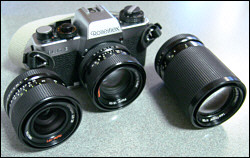Rolleiflex SL35 E

|
|
|
| Style, film format | 35mm interchangeable lens single-lens reflex system |
|
|
|
| Lens, shutter | f/1.8 50mm Planar, vertical metal blade |
|
|
|
| Photo quality | Excellent |
|
|
|
| Ergonomics | Nice although tendency to inadvertently push depth-of-field preview |
|
|
|
I've been interested in trying a Rolleiflex 35mm SLR for some time. I remember them being advertised in the base exchange (BX) catalog when I was in the Air Force, but at that time in my life -- while being stationed in Germany -- I knew that I had to have a Japanese camera. Go figure.
The SL35 E was the last of the Rolleiflex SL35 cameras, although not the final Rolleiflex 35mm SLR, which I'll discuss briefly later.
As with some other Rollei cameras, production of the Rolleiflex SL35 began in Germany but was later moved to Singapore, and this proved to be problematic because it seems that the quality control just wasn't there.
The SL35 E was the sister model of a Voigtlander camera. Both were produced only in Singapore. How Rollei ended up with the Voigtlander name is a story in itself.
After the demise of Zeiss Ikon, the Voigtlander brand passed to Rollei. It didn't come at an ideal time, as Rollei was experiencing its own cash difficulties and then went through a series of financial problems not long after.
The camera itself is an able performer, although my camera's meter is not working correctly. The viewfinder uses a diagonal split image to assist with focusing. The viewfinder image is large and wonderfully bright, even with an f/4.0 lens. Try that with most cameras, and you'll encounter a dim screen in which half of the split image blacks out.
In keeping with the times, the shutter speed and aperture are displayed in the viewfinder. The frame counter doesn't advance unless the film is loaded correctly. If the film doesn't move out of the cassette, the frame counter doesn't move.
• 1974: SL350
• 1976: SL35 M
• 1976: SL35 ME
• circa 1979: SL35 E
The best thing about these cameras wasn't the bodies. It was the Carl Zeiss glass that was available. Before Yashica began production of Contax SLR bodies and Zeiss lenses in Japan, some of the better Zeiss glass was first available in the Rollei QBM mount.
I started with a three-lens set that includes the f/1.8 50mm Planar, f./2.8 35mm Distagon and f/4.0 135mm Tele-Tessar. These are the later lenses that are Rollei-branded with HFT (High Fidelity Transfer) lens coating. I believe these are QBM III lenses, which are compatible with the earlier bodies. Since then, I've added several other lenses: a Schneider-Kreuznach f/1.8 Xenon, f/2.8 85mm Sonnar, f/2.8135mm Sonnar and the f/4.0 200mm Tele-Tessar.
I've consistently gotten incredibly sharp photos with this camera, and the Planar and Distagon lenses focus much closer than comparable lenses from other camera makers. The great thing today is that these are readily available on the used market. Your only problem will be finding a good body, as I have been less than impressed with the Singapore bodies.
However, the Rolleiflex 35mm cameras that still command a high price -- even on the used market -- are the SL2000 and 3003 systems. Reportedly, these were Contarex designs that would have been produced by Zeiss Ikon had it not folded.
